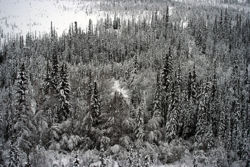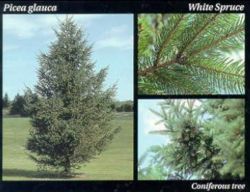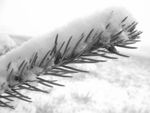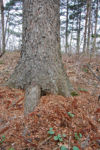White spruce
| White spruce |
|---|

|
| Scientific Classification |
| Binomial Name |
|
Picea glauca |
The White Spruce is also known as the Western White Spruce and Canadian Spruce. It's mainly found in North America, but other places around the world as well. These trees can reach over 100 feet in height. They can grow in a variety of climates from moist to somewhat dry. This organism mainly reproduces by seeds. The seeds can either be blown by the wind, or carried off by animals such as squirrels.
Anatomy
The White Spruce is a medium sized tree. It is a conifer that is native to the U.S. and has a narrow "spire like crown." These trees can reach over 100 feet in height. [1] The trunk can have width of about a meter. [2] The Spruce does not really have leaves, instead they have things that tend to look more like needles. Theses needles have four sides and are a bluish green color, averaging about three-quarters of an inch long. The branches of this magnificent plant are self pruning and protrude from the organism in dense clusters. The crown of the tree is about half way up. It doesn't have a very thick bark, usually less than 0.3 inches in thickness. The outer covering can either be smooth or kind of scaly in a light grey brownish color. The roots usually extend to a depth of about 3 or 4 feet. The taproots and sinker roots will go even deeper to about 10 feet. In northern places, big roots can be found to be even within 6 inches of the mineral soil surface. The Spruce yields a fruit known as the cone. A brown, oval shaped cone, normally about 2 inches long. Which hangs by small stems on the upper branches of the crown. [3]
Reproduction
The White Spruce has an extensive means of reproduction. Its main means of reproduction is by seeds. It’s also done vegetatively by a process called layering. The first of seed production occurs when the tree has existed for four years. Although, the seed process is not a great quantity until the organism is about 30 years or more old. The seeds are about an eighth of an inch long, and a quarter to a third of an inch wing. The main way that seeds are dispersed without human help is the wind. Most seeds tend to fall within about 300 feet of the place where it began. However, some have even been found to be almost a mile away! There are also red squirrels which carry the seeds off to different places. The seeds are only good for about 1-2 years. The seeds will sit over winter and germinate in the summer when the ground is nice and moist. [4]
Ecology
The White Spruce exists transcontinentally. These trees mainly exist in boreal forests. Loams, clays, and silt-loams are the main places where the White Spruce tends to thrive. Sandy soils, however, are some of the worst conditions for this plant. It does not grow well in places with a high water table.[5] It will not live in places where there is stagnant water which reduces the root volume. On the other hand, it will exist in dry places, just as long as the climate is not too arid. [6]The primary ways that these plants die are from stem and needle rusts, root diseases, weevils, and other wood eating insects.[7]
Related References
- The White Spruce
- White Spruce By: Wikipedia
- Pictures of White Spruce Trees By: Flikr
- Boreal Forest
- USDA White Spruce



